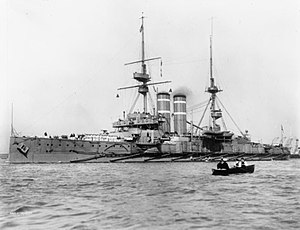HMS Hindustan (1903)

HMS Hindustan
|
|
| History | |
|---|---|
|
|
|
| Name: | HMS Hindustan |
| Namesake: | The Indian Empire |
| Ordered: | 1902/03 Estimates |
| Builder: | John Brown & Company, Clydebank |
| Cost: | £1,450,652 |
| Laid down: | 25 October 1902 |
| Launched: | 19 December 1903 |
| Completed: | March 1905 |
| Commissioned: | 22 August 1905 |
| Decommissioned: | 15 May 1918 |
| Nickname(s): | The King Edward VII-class battleships were known as "The Wobbly Eight" |
| Fate: | Sold for scrapping 9 May 1921 |
| General characteristics | |
| Class and type: | King Edward VII-class pre-dreadnought battleship |
| Displacement: | Standard 16,350 tons (as built) |
| Length: | 453 ft 8 in (138.28 m) |
| Beam: | 78 ft (24 m) |
| Draught: | 25 ft 6 in (7.77 m) |
| Installed power: | 18,000 ihp |
| Propulsion: | Coal fired (with oil sprayers) water tube boilers, two 4-cylinder vertical compound expansion stream engines, 2 screws, |
| Speed: | 18.5 knots (34 km/h) |
| Range: | 2,000 nautical miles (3,704 km) at 18.5 knots (34 km/h); 5,270 nautical miles (9,760 km) at 10 knots (18.5 km/h) |
| Complement: | 777 |
| Armament: |
|
| Armour: |
|
| Notes: | 2,164–2,238 tons coal maximum, 380 tons oil |
HMS Hindustan was a King Edward VII-class pre-dreadnought battleship of the Royal Navy. Like all ships of the class (apart from HMS King Edward VII) she was named after an important part of the British Empire, namely the Indian Empire. Commissioned in mid 1905, she served with firstly the Atlantic Fleet and then the Channel Fleet. When the latter fleet was reorganised to the Home Fleet, she was attached to that fleet.
In 1912, Hindustan and her King Edward VII-class sister ships formed the 3rd Battle Squadron. The squadron was assigned to the Grand Fleet at the beginning of World War I, and served on the Northern Patrol. In 1916, she, with the rest of the squadron was transferred to Nore Command until she was detached in February 1918 to serve as a parent ship for the raids on Zeebrugge and Ostend. Decommissioned in May 1918, she finished the war as an accommodation ship, and was disposed of in 1919.
HMS Hindustan was built by John Brown & Company at Clydebank. She was laid down on 25 October 1902 and launched on 19 December 1903. She began trials in January 1905 and was completed in March 1905.
Although Hindustan and her seven sister ships of the King Edward VII class were a direct descendant of the Majestic class, they were also the first class to make a significant departure from the Majestic design, displacing about 1,000 tons more and mounting for the first time an intermediate battery of four 9.2-inch (234-mm) guns in addition to the standard outfit of 6-inch (152-mm) guns. The 9.2-inch was a quick-firing gun like the 6-inch, and its heavier shell made it a formidable weapon by the standards of the day when Hindustan and her sisters were designed; it was adopted out of concerns that British battleships were undergunned for their displacement and were becoming outgunned by foreign battleships that had begun to mount 8-inch (203-mm) intermediate batteries. The four 9.2-inch were mounted in single turrets abreast the foremast and mainmast, and Hindustan thus could bring two of them to bear on either broadside. Even then, Hindustan and her sisters were criticised for not having, a uniform secondary battery of 9.2-inch guns, something considered but rejected because of the length of time it would have taken to design the ships with such a radical revision of the secondary armament layout. In the end, it proved impossible to distinguish 12-inch and 9.2-inch shell splashes from one another, making fire control impractical for ships mounting both calibres, although Hindustan had fire-control platforms on her fore- and mainmasts rather than the fighting tops of earlier classes.
...
Wikipedia
